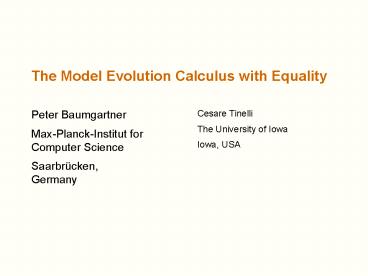The Model Evolution Calculus with Equality - PowerPoint PPT Presentation
1 / 36
Title:
The Model Evolution Calculus with Equality
Description:
The Model Evolution Calculus with Equality. Peter ... Recently increased interest in Instance Based Methods ... Disconnection Method [Billon], DCTP [Letz&Stenz] ... – PowerPoint PPT presentation
Number of Views:37
Avg rating:3.0/5.0
Title: The Model Evolution Calculus with Equality
1
The Model Evolution Calculus with Equality
- Peter Baumgartner
- Max-Planck-Institut for Computer Science
- Saarbrücken, Germany
Cesare Tinelli The University of Iowa Iowa,
USA
2
Background and Motivation
- Recently increased interest in Instance Based
Methods - Ordered Semantic Hyper Linking Plaisted et
al,Primal Partial Instantiation Hooker et
al,Disconnection Method Billon, DCTP
LetzStenz,First-Order DPLL B., Model
Evolution B.Tinelli,Inst-Gen
GanzingerKorovin - Reduce proof search in first-order (clausal)
logic to propositional logic in an intelligent
way - Different to Resolution, Model Elimination,
(Pros and Cons) - Inference rules for equality in Instance Based
Methods - So far only for Inst-Gen and DCTP
- How to add equality handling to Model Evolution?
3
Contents
- DPLL as a starting point for the Model Evolution
calculus - Model Evolution calculus
- Adding inference rules for equality
4
DPLL - Idea
Davis-Putnam-Logemann-Loveland Procedure
(1960-63) Propositional core
Input Propositional clause set Output Model
or unsatisfiable
A
A
B
Semantic tree enumerates interpretations
B
Algorithm components - Simplification - Split
- Backtracking
C
C
5
Beyond DPLL
- Recent research in propositional satisfiability
(SAT) has been very successful. - The best modern SAT solvers (satz, MiniSat,
zChaff, Berkmin,) are based on DPLL. - Can DPLL be lifted to the first-order level?
- Can we combine successful SAT techniques (unit
propagation, backjumping, learning,) with
successful first-order techniques?(unification,
subsumption, ...)?
6
Model Evolution Calculus Idea
Lifing of tree data structure and derivation
rules to first-order
Input First-order clause set Output Model or
unsatisfiable if termination
Semantic tree enumerates interpretations
Procedure components - Simplification - Split
- Backtracking
Interpretation induced by a branch?
7
Interpretation Induced by a Branch Examples
Branch ? p(u,v)
p(u,v)
- ? produces every instance of p(u,v)
- Closely related Interpretation induced by ?
assigns true to every instance of p(u,v)
8
Interpretation Induced by a Branch Examples
? p(u,v), ?p(u,u)
p(u,v)
?p(u,u)
- ? produces every instance of p(u,v) except
the instances of p(u,u) - ? produces every instance of ?p(u,u)
- Interpretation induced by ? determined by
produced ground instances
9
Interpretation Induced by a Branch Examples
? p(u,v), ?p(u,u), p(f(u),f(u))
p(u,v)
?p(u,u)
p(f(u),f(u))
10
Interpretation Induced by a Branch Examples
? ?p(f(u),v), p(u,g(v))
OK
?p(f(u),v)
p(u,g(v))
p(f(u),g(v))
- ? produces e.g. both p(f(a),g(a)) and
p(f(a),g(a)) - Induced interpretation gives preferrence to
positive literal p(f(a),g(a)) is true
11
Interpretation Induced by a Branch Examples
? ?p(f(u),v), p(u,g(v)), p(b,g(v))
OK
?p(f(u),v)
p(u,g(v))
p(b,g(v))
12
Interpretation Induced by a Branch Examples
? ?p(u,v), p(u,v)
Not OK! Contradictory
?p(u,v)
p(u,v)
13
Interpretation Induced by a Branch Examples
? p(u,v), 8x ?p(x,x)
p(u,v)
?p(x,x)
? produces every instance of ?p(x,x)with no
possible exceptions
14
Interpretation Induced by a Branch Examples
? p(u,v), ?p(x,x), p(f(u),f(u)
Not OK! Contradictory
p(u,v)
?p(x,x)
p(f(u),f(u))
15
Initial Context
? ?v
?v
- ? produces no positive literals
- Well consider only extensions of ?v
16
Model Evolution Calculus Idea (contd)
Lifting of semantic trees and derivation rules to
first-order
How to determine Split literal? Calculus?
17
Derivation Rules Simplified (1)
Split
2. violated
2. satisfied
18
Derivation Rules Simplified (2)
Close
2. satisfied
2. satisfied
Close is applicable
19
Derivation Rules Simplification Rules (1)
Propositional level
Subsume
First-order level ¼ unit subsumption
- All variables in context literal L must be
universally quantified - Replace equality by matching
20
Derivation Rules Simplification Rules (2)
Propositional level
Resolve
First-order level ¼ restricted unit resolution
- All variables in context literal L must be
universally quantified - Replace equality by unification
- The unifier must not modify C
21
Derivation Rules Simplification Rules (3)
Compact
22
Derivations and Completeness
23
Equality
- Design decision
- Total theory reasoning a la GanzingerKorovin
ORPartial theory reasoninga la LetzStenz - Our approachPartial theory reasoning
(Paramodulation) - Generalizations
- Branch represents E-Interpretation now
- Paramodulation inference rules
- Redundancy
Will talk about generalizations in this order
24
E-Interpretation Induced by a Branch
Construction of the Rewrite System
25
E-Interpretation Induced by a Branch (contd)
- The model construction technique has been
developed for the Superposition calculus
BachmairGanzinger - Relevant here in particular special case of unit
clauses - Differences due to parametric literals
- Nonmonotonicity
- Have to work with two orderings term ordering
and instantiation ordering - Model constructionsmaller sides of equations
must be irreducible, too, in order to be turned
into rewrite rules - In consequence, paramodulation into smaller sides
is neccessary (really?)
26
Paramodulation and Constrained Clauses
Calculus Idea
Paramodulation inference, first attempt (unsound)
Para
Close
27
Paramodulation and Constrained Clauses
Paramodulation inference second attempt (sound)
Para
28
Derivation Rules (1)
Para
29
Derivation Rules (2)
Ref
30
Derivation Rules (3)
Split
Note item 3 Variables are OK, just presentation
is simplified here
31
Derivation Rules (4)
Close
32
Derivation Example
Para
Simp
Split (left)
33
Optional Derivation Rules (1)
Assert
if see paper
Examples
No Split for unit clauses
With equality resoning
34
Optional Derivation Rules (2)
Simp
Examples
Delete a clause whose constraint will never be
satisfied
Simplify constraint
Generic Simp rule covers most simplification
rules so far as special cases
35
Fairness
36
Conclusions
- Main result soundness and refutational
completeness - Nice features (perhaps)
- Paramodulates only unit equations into clauses
- No paramodulation inferences between context
equations or into constrained literals - Clause part of constrained clauses does not grow
in length(decide Bernays-Schoenfinkel clauses
with equality) - Works with explicitly represented model
candidateat the calculus level (the context) - Not so nice features (perhaps)
- Semantic redundancy criterion based on model
candidate difficult to exploit - Need paramodulation into smaller sides of
equations (really?)































